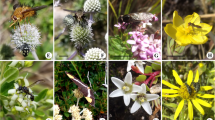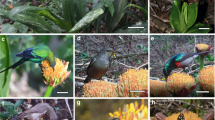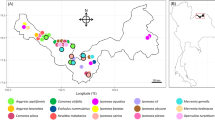Abstract
The genus Zamia (Zamiaceae: Cycadales) exhibits its greatest diversity in Colombia and is highly threatened by habitat loss, extraction for ornamental plant trade, and mining, among other factors. One of the most important considerations for the effective conservation of Zamia is its highly specialized reproductive biology. Despite the importance of pollination for the populations’ viability, no studies have examined the pollination process of cycads in Colombia. Herein, we describe the pollination process of Zamia incognita A. Lindstr. & Idárraga, in a natural population. Exclusion experiments were performed by selectively excluding wind, beetles, both, or neither, which demonstrated that Pharaxonotha beetles are effective pollinators of Zamia incognita and that wind does not play any role as pollen vector. By following beetles marked with fluorescent dyes and directly observing beetle movements on and into female cones and micropyles, we confirmed that Pharaxonotha sp. is the effective pollinator of Z. incognita. The beetles traveled a maximum dispersal distance from a male to female cone of nearly 22 m and a minimum distance of 5 m. We found Pharaxonotha beetles in male cones, where they complete their life cycle. Cones produce heat in a circadian pattern associated with the elongation of the cones and pollen shedding. The increase in cones’ temperature appears to play an important role in beetle attraction. We suggest that pollination droplets on the micropyles would be a reward to pollinators. We also discuss the relationship of this Zamia species with other insects, which have important consequences for the conservation of web interactions.






Similar content being viewed by others
References
Aho KA (2014) Foundational and applied statistics for biologist using R. CRC Press, Boca Raton
Aristizábal A, Tuberquia DJ, Martínez D, Parra G (2011) Caracterización de poblaciones naturales de dos especies amenazadas de Zamia (Zamiaceae), en el Magdalena Medio Antioqueño. Memorias del Congreso Colombiano de Botánica. Cali, Colombia
Ashman T-L (2009) Sniffing out patterns of sexual dimorphism in floral scent. Funct Ecol 23:852–862
Bond WJ (1994) Do mutualisms matter? Assessing the impact of pollinator and disperser disruption on plant extinction. Philos Trans R Soc B 344:83–90
Cáceres RA, Berrío MA, Hincapié Posada JE (eds) (2010) Atlas de Áreas Protegidas Departamento de Antioquia. Sistema Departamental de Áreas Protegidas de Antioquia. Parques Nacionales Naturales de Colombia, Antioquia, Colombia
Calonje M (2009) A new cliff-dwelling species of Zamia (Zamiaceae) from Belize. J Bot Res Inst Tex 3:23–29
Calonje M, Stevenson D, Calonje C, Ramos YA, Lindstrom A (2010) A new species of Zamia from Chocó, Colombia (Cycadales, Zamiaceae). Brittonia 62:80–85
Calonje M, Esquivel HE, Stevenson D, Calonje C, Pava D (2011) A new arborescent species of Zamia from the Central Cordillera of Tolima, Colombia (Cycadales, Zamiaceae), with comments on the Z. poeppigiana species complex. Brittonia 63:442–451
Chapman RF (1998) The Insects: structure and function. Cambridge University Press, Cambridge, 770 pp
Chaves R, Genaro JA (2005) A new species of Pharaxonotha (Coleoptera: Erotylidae), probable pollinator of the endangered Cuban cycad, Microcycas calocoma (Zamiaceae). Insecta Mundi 19:143–150
Condamine FL, Nagalingum NS, Marshall CR, Morlon H (2015) Origin and diversification of living cycads: a cautionary tale on the impact of the branching process prior in Bayesian molecular dating. BMC Evol Biol 15(1):65. doi:10.1186/s12862-015-0347-8
Donaldson JS (1997) Is There a floral parasite mutualism in cycad pollination? The pollination biology of Encephalartos villosus (Zamiaceae). Am J Bot 84:1398–1406
Eriksson R (1994) The remarkable weevil pollination of the neotropical Carludovicoideae (Cyclanthaceae). Plant Syst Evol 189:75–81
Ervik F, Tollsten L, Knudsen JT (1999) Floral scent chemistry and pollination ecology in phytelephantoid palms (Arecaceae). Plant Syst Evol 217:279–297
Farrell BD (1998) “Inordinate Fondness” Explained: Why Are There So Many Beetles? Science 281:555–559
Franz N, Skelley PD (2008) Pharaxonotha portophylla (Coleoptera: Erotylidae), new species and pollinator of Zamia (Zamiaceae) in Puerto Rico. Caribb J Sci 44:321–333
Galeano G, Bernal R, Calderón E, García N, Cogollo A, Idárraga A (2005) Zamias (familia Zamiaceae: géneros Zamia y Chigua). In Libro Rojo de Plantas de Colombia, Instituto Alexander von Humboldt - Instituto de Ciencias Naturales de La Universidad Nacional de Colombia - Ministerio del Medio Ambiente, Vivienda y Desarrollo Territorial, Bogotá, 454 pp
González F (2004) Herbivoría en una gimnosperma endémica de Colombia, Zamia encephalartoides (Zamiaceae) por parte de Eumaeus (Lepidoptera: Lycaenidae). Rev Acad Colomb Ciencias 28:233–244
Gorelick R (2001) Did insect pollination cause increased seed plant diversity? Biol J Linn Soc 74:407–427
Gottsberger G (1999) Pollination and evolution in neotropical Annonaceae. Plant Species Biol 14:143–152
Hall JA, Walter GH (2013) Seed dispersal of the Australian cycad Macrozamia miquelii (Zamiaceae): are cycads megafauna-dispersed “grove forming” plants? Am J Bot 100:1127–1136
Hall JA, Walter GH, Bergstrom DM, Machin P (2004) Pollination ecology of the Australian cycad Lepidozamia peroffskyana (Zamiaceae). Aust J Bot 52:333–343
Haynes JL. World list of cycads: A historical review. IUCN/SSC Cycad Specialist Group. c2009 - [modified 2012; cited 2014 feb 10]. http://www.cycadsg.org/publications/Haynes-Historical-Review-of-World-List-of-Cycads-2012.pdf
Henderson A (1986) A review of pollination studies in the Palmae. Bot Rev 52:221–259
Idárraga A, Calonje M, López-Gallego C (2015) Zamia incognita A. Lindstr. & Idarraga. In Bernal R, Gradstein SR, Celis M (eds.). Catálogo de plantas y líquenes de Colombia. Instituto de Ciencias Naturales, Universidad Nacional de Colombia, Bogotá. http://catalogoplantascolombia.unal.edu.co [cited 2016 jan 23]
Jin B, Jiang X, Wang D, Zhang L, Wan Y, Wang L (2012) The behavior of pollination drop secretion in Ginkgo biloba L. Plant Signal Behav 7:1168–1176
Kearns CA, Inouye DW (1993) Techniques for pollination biologists. University Press of Colorado, Boulder
Keller LF, Waller DM (2002) Inbreeding effects in the wild populations. Trends Ecol Evol 17:230–241
Leschen RAB (2003) Erotylidae (Insecta: Coleoptera: Cucujoidea): phylogeny and review. Fauna of N Z 47, 108 pp
Leschen RAB, Skelley PE (2002) Languriidae Wiedeman, 1823. In: Arnett RH Jr., Thomas MC, Skelley PE, Frank JH (eds) American Beetles, vol 2, Polyphaga: Scarabaeoidea to Curculionoidea. CRC Press, Florida, pp 343–347
Lindström AJ, Idarraga A (2009) Zamia incognita (Zamiaceae): the exciting discovery of a new gymnosperm from Colombia. Phytotaxa 2:29–34
Lindström AJ, Calonje M, Stevenson D, Husby C, Taylor A (2013) Clarification of Zamia acuminate and a new Zamia species from Coclé Province, Panama. Phytotaxa 98:27–42
López-Gallego C (2015) Plan de acción para la conservación de zamias de Colombia [Recurso electrónico]/Universidad de Antioquia-Instituto de Biología: López-Gallego Cristina. Bogotá D.C.: Colombia. Ministerio de Ambiente y Desarrollo Sostenible; Universidad de Antioquia, 2015. 163p. :il.
Nepi M, von Aderkas P, Wagner R, Mugnaini S, Coulter A, Pacini E (2009) Nectar and pollination drops: how different are they? Ann Bot 104:205–219
Nepi M, von Aderkas P, Pacini E (2012) Sugary exudates in plant pollination. In: Vivanco JM, Baluška F (eds) Secretions and exudates in biological systems. Springer, Berlin, pp 155–185
Norstog K (1987) Cycads and the origin of insect pollination. Am Sci 75:270–279
Norstog KJ, Fawcett PKS (1989) Insect-cycad symbiosis and its relation to the pollination of Zamia furfuracea (Zamiaceae) by Rhopalotria mollis (Curculionidae). Am J Bot 76:1380–1394
Norstog KJ, Stevenson DW, Niklas KJ (1986) The Role of Beetles in the Pollination of Zamia furfuracea L. fil. (Zamiaceae). Biotropica 18:300–306
O’Brien CW, Tang W (2015) Revision of the new world cycad weevils of the subtribe Allocorynina, with description genera and three new subgenera (Coleoptera: Belidae: Oxycoryninae). Zootaxa 3970:1–87
Oberpieler R (2005) Evil weevils – the key to cycad survival and diversification? In: Lindstrom A (ed) Proceedings of CYCAD2002. Nong Nooch Tropical Garden, Bangkok, pp 170–170
Pakaluk J (1988) Review of the new world species of Pharaxonotha Reitter (Coleoptera: Languriidae). Rev Biol Trop 36:447–451
Pellmyr O, Thien LB (1986) Insect reproduction and floral fragrances: keys to the evolution of the angiosperms? Taxon 35:76–85
Proches Ş, Johnson SD (2009) Beetle pollination of the fruit-scented cones of the South African cycad Stangeria eriopus. Am J Bot 96:1722–1730
R Core Team (2015). R: A language and environment for statistical computing. R Foundation for Statistical Computing, Vienna, Austria. https://www.R-project.org/
Samways MJ (2007) Insect conservation: a synthetic management approach. Annu Rev Entomol 52:465–487
Schutzman B, Vovides AP (1998) A New Zamia (Zamiaceae, Cycadales) from Eastern Chiapas, Mexico. Novon 8:441–446.
Simpson MG (2006) Plant Systematics. Elsevier Academic Press, Boston
Stevenson D (2001) Cycadales. Instituto de Ciencias Naturales, Universidad Nacional de Colombia, Bogotá
Stevenson DW, Norstog KJ, Fawcet PKS (1998) Pollination biology of cycads. In: Owens SJ, Rudall PJ (eds) Reproductive biology. Royal Botanic Gardens, Kew, pp 277–294
Suinyuy TN, Donaldson JS, Johnson SD (2009) Insect pollination in the African cycad Encephalartos friderici-guilielmi Lehm. South Afr J Bot 75:682–688
Tang W (1987a) Insect pollination in the cycad Zamia pumila (Zamiaceae). Am J Bot 74:90–99
Tang W (1987b) Heat production in cycad cones. Bot Gaz 148:165–174
Tang W (1989) Seed dispersal in the cycad Zamia pumila in Florida. Can J Bot 67:2066–2070
Taylor BAS, Haynes JL, Holzman G (2008) Taxonomical, nomenclatural and biogeographical revelations in the Zamia skinneri complex of Central America (Cycadales: Zamiaceae). Bot J Linean Soc 158:399–429
Taylor Blake AS, Holzman G (2012) A New Zamia species from the Panama Canal area. Bot Rev 78:335–344
Terry I (2001) Thrips and Weevils as dual, specialist pollinators of the Australian cycad Macrozamia communis (Zamiaceae). Int J Plant Sci 162:1293–1305
Terry I, Moore CJ, Walter GH, Forster PI, Roemer RB, Donaldson JD, Machin PJ (2004) Association of cone thermogenesis and volatiles with pollinator specificity in Macrozamia cycads. Plant Syst Evol 243:233–247
Terry I, Walter GH, Donaldson JS, Snow E, Forster PI, Machin PJ (2005) Pollination of Australian Macrozamia cycads (Zamiaceae): effectiveness and behavior of specialist vectors in a dependent mutualism. Am J Bot 92:931–940
Vovides AP (1991) Insect symbionts of some Mexican cycads in their natural habitat. Biotropica 23:102–104
Vovides AP, Ogata N, Sosa V, Peña-García E (1997) Pollination of endangered Cuban cycad Microcycas calocoma (Miq.) A.DC. Bot J Linn Soc 125:201–210
Wagner RE, Mugnaini S, Sniezko R, Hardie D, Poulis B, Nepi M, Pacini E, von Aderkas P (2007) Proteomic evaluation of gymnosperm pollination drop proteins indicates highly conserved and complex biological functions. Sex Plant Reprod 20:181–189
Wilson GW (2002) Insect Pollination in the Cycad Genus Bowenia Hook. ex Hook. f. (Stangeriaceae). Biotropica 34:438–441
Wilson PJ, Provan J (2003) Effect of habitat fragmentation on levels and patterns of genetic diversity in natural populations of the peat moss Polytrichum commune. Proc R Soc London Ser B 270:881–886
Acknowledgements
We are grateful to Gloria Montoya and Gedwin Valencia for their unconditional support and help in processing data. Cornelio Bota, Camilo Flórez, Laura Gómez Mesa, Miguel González, Laura Marín, David Taborda, and Yeison Montoya provided invaluable assistance in the field. Yeison Montoya and Cornelio Bota enhanced this manuscript with their field observations, and Cornelio allowed us to use one of his photographs. Gustavo Londoño and Juan Luis Parra kindly lent us the temperature recording equipment. We thank María José Sanín, Henry Arenas-Castro, Sergio A. Muñoz-Gómez, Edwin Hurtado, Nicolás González-Castro, Yenny Correa-Carmona, Alejandra Duque, Federico Tamayo, and Arturo Aristizábal for constructive input; Cornelio Bota and Cristina López-Gallego for valuable comments on the manuscript; and Sheela Turbek for her generous final English review. William Tang, Irene Terry, Robert Roemer, and Shayla Salzman provided important recommendations at Cycad 2015. We are grateful to our reviewers for their patient English review and important comments. We also thank the Fundación Alejandro Ángel Escobar for financial support through the Colombia Biodiversa Grant and the Biology program at Universidad CES for supporting our laboratory and fieldwork. Diana María Carmona and Ahída Paulina Herrera provided logistical assistance through the Sciences labs at Universidad CES. Marta Wolff and Grupo de Entomología de la Universidad de Antioquia (GEUA) kindly provided laboratory resources during the initial stages of this work, and the Invertebrate Collection at the University of Puerto Rico allowed us to use their photography equipment. Finally, we express our gratitude to all of the people at La Hacienda Santa Bárbara, from Maceo, for their kind help with logistics in the field. This manuscript is dedicated to the Magdalena Medio region—may the magic of its forests survive the people indifference and continue telling stories.
Author information
Authors and Affiliations
Corresponding author
Additional information
Handling Editor: Katja Hogendoorn.
Rights and permissions
About this article
Cite this article
Valencia-Montoya, W.A., Tuberquia, D., Guzmán, P.A. et al. Pollination of the cycad Zamia incognita A. Lindstr. & Idárraga by Pharaxonotha beetles in the Magdalena Medio Valley, Colombia: a mutualism dependent on a specific pollinator and its significance for conservation. Arthropod-Plant Interactions 11, 717–729 (2017). https://doi.org/10.1007/s11829-017-9511-y
Received:
Accepted:
Published:
Issue Date:
DOI: https://doi.org/10.1007/s11829-017-9511-y




